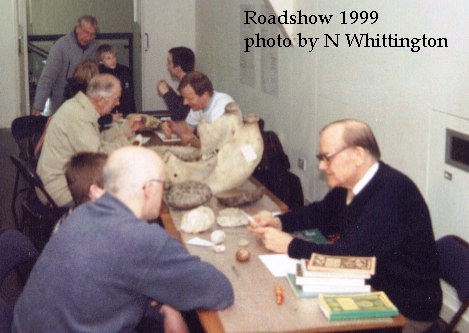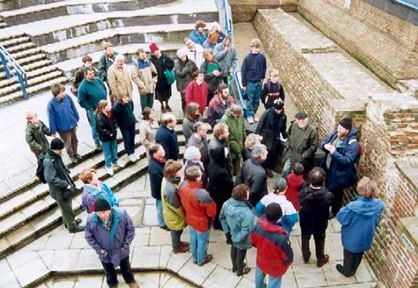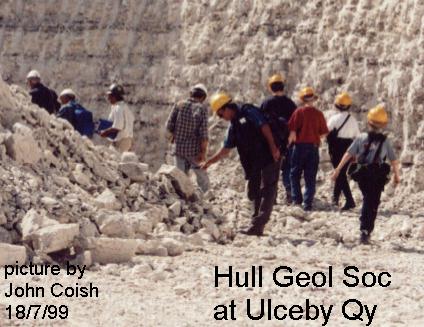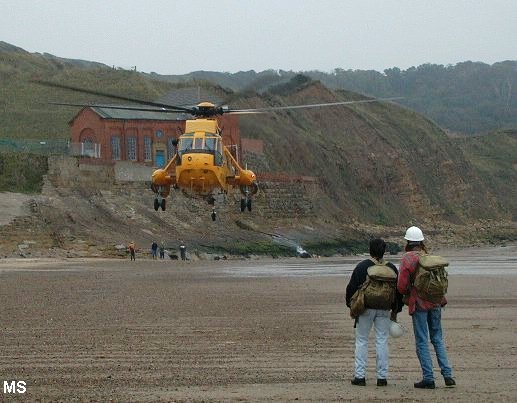

Humberside Geologist no 13
Where does the Society's year start? January 1st, the Committee meeting that plans the activities for the next 12 months, the Annual General Meeting when the new officers are elected, June with the anniversary of the Society's formation, or September 30th when subscriptions are due and the Winter Programme begins? Not knowing the answer to the question, I shall start with the AGM.
At the AGM in March 1999 we resolved the problems over the trustees of the Conservation Fund and elected a new Committee. Nigel Whittington was asked to run the official Society web-site. Chris Blackhurst was asked to act as official first aider on field trips. We were disappointed that Eric Robinson, who could be described as the UK's no. 1 urban geology enthusiast, could not attend because he was recovering from a hip replacement operation. But, very kindly and at very short notice, Martyn Pedley stepped in and gave us a talk about his researches into modern tufas in Derbyshire, using ground penetrating radar and other techniques.
Science Week (or SET99) was in March and 1999 also marked the 700th Anniversary of Hull receiving its Royal Charter as a City. Lots of events were organised and our Society contributed two events. At the beginning of the week we did a Rock and Fossil Roadshow at the Hull and East Riding Museum, in High Street. Members of the Society and museum staff were on hand to identify specimens. We had over forty enquiries. Matt Stephens of the Museum organised a competition for younger geologists and the opportunity to make plaster casts of fossils.

On Sunday 21st March - there was a geological walk around the Old Town for RockWatch. We started outside the Tourist Information Office in Queen Victoria Square at 10 am. About 50 people attended the walk. I was pleased that other people on the walk made useful contributions, Matt Stevens from Hull Museums explaining some of the geology and Chris Ketchell from Hull College explaining some of the history. Nigel Whittington photographed the event. As a result of meeting Chris, I arranged a guided walk with him for the autumn around Spring Bank Cemetery.

Our first field trip was on 17th April to the Ryedale Windypits, led by Richard Myerscough. This was a follow-up to a lecture he had given in January. We met up at the Sutton Bank Visitors' Centre at the top of the hill on a misty spring morning and wandered along the top of Whitestone Cliff to see some of the caves. We had lunch at the Hambleton Pub and then went to Rievaux Abbey to look at a riverbank section and a disused quarry. Twelve members and guests attended the meeting.

The RockWatch meeting at Hornsea went well on 15th May - people coming from Hexham, Doncaster, Leeds and York, as well as some who picked up details at the Roadshow and our own Hull G S members, making a total of about 25. I was pleased that Ron Harrison was there to help, and he gave a quick impromptu talk about glacial erratics whilst I sorted out some late arrivals. We did not find anything spectacular, but I listed 26 different rocks and fossils, and those new to the hobby, I hope, had a good introduction.
The East Yorkshire RIGS meeting arranged at short notice for 20th May was cancelled at even shorter notice. I had also been looking forward to a Yorkshire regional meeting where the RIGS groups in the regional could compare notes, problems and successes. The Huddersfield group agreed in 1998 to arrange it, but I only received full details on June 1st for the meeting on June 12th, so it was too late to persuade members to go. Perhaps another one will be planned for next year?
The 111th Anniversary Dinner was held at the West Bulls, at the corner of Bricknall Avenue and Cottingham Road. Seventeen members and guests attended the informal event. I was relieved that there were no late additions as it was set up as one long table. An added treat was that there was a special offer on so, the meal cost half what we predicted. The carvery servings were very generous and the vegetarian hazelnut and brown rice roast was also popular.
Terrible weather was forecast for our trip to Whitby on 5th June, but the forecast was completely wrong. Mick Stanley had arranged a visit to Whitby Museum, followed by a fish and chip lunch and then a quick bit of fossil collecting on the wave cut platforms to the East. 23 members and guests attended, including Vicky Mason the National RIGS officer and Lesley Anderton from Vancouver who had read about the meeting on our Web Site! The Museum was fascinating, large ichthyosaurs and a plesiosaur (which had been recently conserved) embedded in the plaster on the wall, and enormous numbers of local fossils. I counted 63 holotype ammonites on display (and I am sure I missed a few). Lunch was in Anderson's Bistro and then we made our way to the East Pier. I was pleased that we had asked Chris to provide his first aid services for our meetings, as I slipped on the slippery mudstones and cut my hand! (another first). We found lots of belemnites, Dacromya [or Nuculana or Leda] ovum, and a few Hildoceras and Dactylioceras ammonites.
A week later I heard the sad news that Mark Piasecki had died. I sent messages or 'phoned some members who remembered him. Spontaneously they told me anecdotes about field trips or classes with Mark. One friend, remembering the catchphrase 'garnets as big as your fist', replied that we would never be able to find a garnet as big as his heart!
Then came a request from the Prof. Richard Moody, President of the Geologists' Association, for a meeting of affiliated groups. After consulting some of the Committee it was agreed that a Saturday afternoon would be best. I asked Matt Stevens at the Museum if he could host the meeting, and he kindly arranged for a room to be available at the Ferens Art Gallery for 24th July. The actual meeting was poorly attended, with only one delegate from outside our Society who represented the Leeds Geological Association and the Mid-Week Geology Club. We discussed our relationship with the G.A., ways of attracting more people into geological clubs and the possibility of Yorkshire hosting the G.A.'s Annual Reunion as part of a Festival of Geology in 2004.
On July 3rd, 16 of us went to Sandsend led by Richard Myerscough. It was an eventful trip for me because someone ran into the back of my car on the way to Cottingham Green, but Bob Head was able to give me lift to the meeting. The tide only uncovers the wave cut platform for a few hours. Firstly we visited the old alum quarries on the top of the cliff, with their moon-like landscape. After lunch we went on the platform to admire the numerous pyritised Harpoceras ammonites and saw where a fossil crocodile had been found two years ago. The trip ended with a drive to Sleights Moor to see dinosaurs' footprints and ripple marked sandstone in a quarry.

Paul Hildreth led a trip to some of Lincolnshire's Chalk pits in July, 23 members and guests attended. We started of at Ulceby Vale Quarry, which had been deepened considerably since I was last there. We had a good time collecting from the Ulceby Oyster Bed, one of those rare horizons in the chalk that is full of fossils. Then we had a quick look at Deepdale Pit and went for lunch at the Cross Keys pub at Grasby. The afternoon was spent at Mansgate Quarry near Nettleton, which exposes the Grasby Marl at the top and goes down almost to the base of the Chalk.

As Secretary I receive lots of information from other Societies and organisations running geological events and courses. I try to pass this on to members as best as I can at meetings, but wanted to find a way of doing it faster. So in September I started an e-mail newsletter containing news queries and gossip. Nigel was doing some impressive work on the Society Web-site and had added a "notice board" for queries and put the whole of Humberside Geologist no. 12 on-line.
In September the Society visited Middlegate Chalk Pit at South Ferriby, led by Felix Whitham. Twelve members attended (unfortunately I had to work that day so missed it) and started the fossil collecting in the Upper Jurassic Clays at the base of the Quarry. They found a wide variety of ammonites and bivalves. The Carstone yielded some rare Nethia bivalves, Moutonithyris brachiopods, Neohibolites belemnites and derived Jurassic ammonites. The Red Chalk was as fossiliferous as ever and some ammonites, echinoids and Inoceramus were found in the Lower Chalk. Nine members spent the afternoon at South Cave Station Quarry, which had not been worked for a while so there was no fresh Kellaways Rock to hammer. Some examples of Gryphea, Catasigaloceras enodatum, belemnites and rhynchonellids were found.
The following day Felix and I went to South Ferriby again - this time for the annual Charity Open Day at the cement works. Felix put on an impressive display of fossils from his collection and about twelve people brought specimens in for identification. I feel that it is always a pleasure to attend the open days - Rugby Portland Cement are always very helpful when we (and other geologists) want to visit the quarry so it is nice to be able to offer something in return.
There was an East Yorkshire RIGS Group meeting on 7th October, when we discussed the organisation of the Group and recent planning applications affecting geologically important sites.
We went to Cayton Bay on 16th October. Seventeen members and guests were led by Terry Rockett and Felix Whitham. We went north to see the Lower Calcareous Grit, just beyond the waterworks once the tide had gone out. It was slippery and one or two people slithered down the side of the sea defences on the way around. There we found Cardioceras ammonites, rhynchonellid brachiopods, fossil wood and nice burrows. After lunch we went south to study the Cornbrash, which was covered in seaweed and some of the party went on to look for the Gristhorpe Plant Bed.

Unfortunately Steve Temperley was unable to come to Hull to give the first lecture in the Winter programme, which was to be a tribute to Mark Piasecki. It was too short notice to find another speaker, and it would probably not have been right to try to find one; so we had a meeting consisting of some Society business and displays of fossils. I wonder what Mark would have thought of that? Let's hope that Steve can come next year.
On 24th October 28 people and one dog turned out in pouring rain for a walk around Spring Bank Cemetery in Hull. I pointed out some of the common rock types used for memorial stones and then Chris Ketchell from the Hull College Local History Unit talked about the history of the older part of the cemetery. I learnt a lot from the trip and hope that some more joint local history and geology trips can be arranged in the future.

In early November I represented the Society at a meeting organised by the British Association about Science Week 2000. We have been holding special public events for Science Week for several years, but this was the first time I had ever met any of the organisers or other participants. It was good to put faces to some of the names, and the meeting encouraged me to get things rolling for our events. We plan to have a Roadshow in the Art Gallery, a walk around town, a microfossil workshop on behalf of RockWatch, a dinosaur field trip and an exhibition at the Central Library.
The November lecture was by Duncan Friend, the national organiser of RockWatch (a geological society for young people). That went a bit wrong too: Duncan was travelling up from Newark so I suggested we went to a pub near the University for a bite to eat before the talk. When we got there the pub was closed for refurbishment - with a small sign saying 're-opening tomorrow'! So we dashed to the West Bulls, ate rapidly and returned just in time for the start of the meeting. The lecture was about the 'Enigmatic creatures of the Burgess Shale.'
The first AGM of the East Yorkshire RIGS Group was held in November at Monument Buildings. Because some people had said that they did not like going to meetings at night-time in town, we held it on a Sunday afternoon, and even fewer people attended! We adopted a new constitution, elected some officers and planned ways of taking geological conservation in the county forward. There are four planning applications affecting RIGS sites, so we have the opportunity to do a bit more than just produce a list of sites!
The talk in December was a bit different; Ben Gearey from the Geography Dept gave a short talk about palynology and its uses in Quaternary studies. But he had also set up some microscopes in the laboratory so we could look at some of the different types of pollen for ourselves. Unfortunately the meeting was not too well attended, perhaps because we had had to change the date, but I think that those attending will remember it for a long while. One member did 'phone me to tell me that changing the date like that was "very naughty"!
Matt Stevens, from the Museum, contacted me urgently to suggest that we jointly apply for a grant to publish a leaflet about a geological trail in Hull. Unfortunately the grant was turned down, but we decided to go ahead and write a leaflet anyway, at a more leisurely pace, and find the funding once it was ready.
The new year (millenium according to some) brought the Members' Evening at Hull and East Riding Museum. I was worried that we would not get enough contributions for the evening, but was proved wrong. Matt Stephens from the Museum displayed some recent acquisitions and minerals and fossils from the collection on loan from Burton Constable Hall. Gordon Binns and Chris Blackhurst displayed specimens from their collection including an enormous Jurassic Nautilus from Hornsea beach. Nigel Whittington had brought along some specimens and photographs from Rumania and Paul Hildreth had brought some from France. Our President, Chris Leach, gave a talk about Geology on the World Wide Web (WWW), I gave a slide show about the summer meetings and Nigel gave a talk about Caving in Rumania (whilst Matt and I did battle with the slide projector). On the way home Nigel revealed that he had originally planned to talk about Geology on the Web and I had admitted that I had too! It would perhaps be nice to have the opportunity for members to explore the web for themselves.
The Committee meeting was the following day (bad planning on my part). We adopted the Safety Policy that had been prepared last year by David Hill, Chris Leach, Terry Rockett and myself. But I was a little bit surprised when the Committee decided that we should ask field meeting leaders to carry out Risk Assessments. I knew that it would come, but not so soon! So Mick Stanley and I agreed to work on a form, and David Hill has helped us too.
The Committee does not meet often (usually annually) and decides on the field meetings for the Summer Programme, suggests speakers for the Winter Programme, nominates the President and Committee for the next year and agonises over the subscriptions. It also makes some policy decisions for the Society, as well as the safety issue this year we agreed to publish articles for Humberside Geologist on the web before the printed version whilst maintaining the same editorial criteria and process.
The Committee meeting basically sets the framework for me (the Secretary) to run the Society's activities for the forthcoming year. I sometimes worry that this is not very democratic. Some Societies have monthly committee meetings, but I inherited this system from Ken Fenton and it seems to work. During the year if I need advice I can discuss the matter with the President or treasurer. These days e-mail makes things easier - I can ask the committee members who are on-line for their opinions. Sometime though there is no time to consult, so I have to make the decision to change the date of a meeting or find another speaker rapidly: there just would not be time to call a Committee Meeting!
The East Yorkshire RIGS Group met at the beginning of February, and seems to be thriving. The active membership is mainly from the Society, and there are obvious links. Fieldwork is the point where the two come together, because the Group does not have liability insurance and can therefore benefit from joint meetings. It does also encourage Society members to be concerned about conservation. In particular information about the state of RIGS in our region is always useful - for example I noticed that Arras Road Chalk Pit is being filled (probably without permission) and reported it to the RIGS Group.
In February, we held a joint public meeting with Hull Museums, at the Ferens Art Gallery. Nigel Whittington and Matt Stephens were busy getting posters distributed, featuring a picture of a dinosaur footprint provide by the speaker Martin Whyte. Nigel came up with a good idea to attract the attention of the media - he donated a dinosaur footprint to the Museums and Matt arranged a press release. The local papers took photographs of the footprint. It even made it on to TV (well "Teletext" at least) where we are informed that the footprint is 160 years old!
February also means that the AGM is approaching rapidly. Felix has to prepare a Treasurer's report and I have to do a Secretary's report. Being a bit dyslexic, I hate to have to read a report to the Society in the way Ken Fenton (the previous Secretary) used to, so I write one. This also means that out-of-town members get updated on the year's successes and failures. Looking back on the year two things seem to have changed. Firstly we are using the world wide web and e-mails more, but Sheila Rogers reminded me that this can exclude members without access to computers, so decided to include a reassurance that this is in addition to rather than a replacement of our usual mailings and Secretary's announcements at meetings. Also, I have noticed a drop in the attendance at lectures and increase in the numbers at field meetings. I wonder if this is because the venue is becoming inconvenient for members, or the lecture topics are not exciting, or the membership is aging and less inclined to go out on an evening, or something else. Perhaps the Society is just changing and we may have to think about the future activities a bit more carefully. But I decide that this is not a crisis, so do not make a big thing of it in my report - let's see what next year brings!
But writing the report reminds me how much I have enjoyed the year and how grateful I am for the existence of the Society. I had a really nice time and it is great to meet with other enthusiasts and gossip about geology, and collect a few specimens together.
The AGM in March was attended by 17 members. We got through the business quite fast and then were pleased to listen to our good friend Eric Robinson enthuse about the joys of urban geology. One thing he said stuck in my mind - he told us how he did his Ph.D. about ostracods which is a pretty specialised topic, but he gets a bigger thrill out of bringing geology to the attention of the public rather than just communicating with a minority of specialists. I must admit that I know how he feels, and now that geology is declining in our schools, we need geological evangelists like Eric more and more.
Following the Committee meeting, Paul Hildreth approached Singleton Birch about possible sponsorship for the Society. They seemed to be interested and offered to pay for Humberside Geologist no. 13 in return for us featuring their logo on programmes in the future, but I was a bit concerned to get the deal onto a more formal basis. The AGM agreed that Paul and I should sort out the details.
So the 12 months in the Society's history comes to an end. But it is a busy time, as we have organised 4 events and a display for Science Week. But to keep to my plan I will have to record these in "Notes and Comments"!
(Thanks to F Whitham for the information about the South Ferriby visit.)
copyright Hull Geological Society 2020